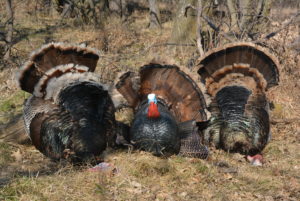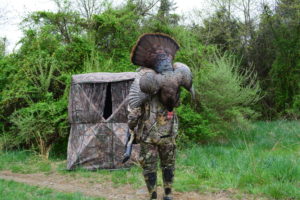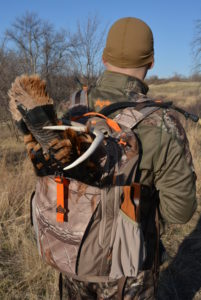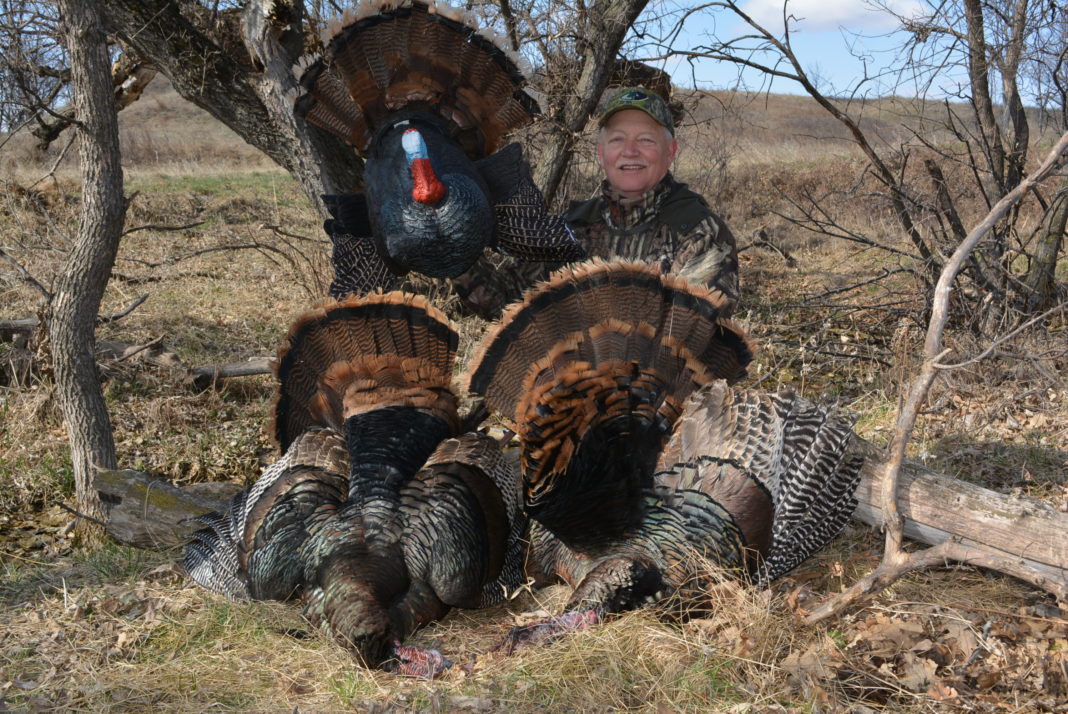Two monster gobblers stood at the far end of a plowed field 200 yards away. One was in full strut, the other pecking in the dirt. My buddy and I were able to crawl along a stream bed below their line of sight. We each had a spring gobbler tag, but only one firearm. Since this was my last day, he handed me the shotgun as we crawled up the stream bank and popped the gobbler decoy above the horizon.

“Here they come” he whispered as one of my most exciting turkey encounters began to unfold. With gobblers high-stepping and beards a swinging, we slid sideways and looked down a two track just outside of a barbed wire fence. In seconds, the gobblers scooted under the wire and ran straight up the road intending to kick an intruder’s butt.
Hiding two adult males behind one decoy was difficult and the toms slammed on the brakes at 20 yards. Boom, the gobbler on the left began to flop. “Hand me the shotgun,” whispered my buddy anxiously and Boom, a second bird went down.
No Need to Call
Maybe the gobblers would have answered hen calls since they were without hens, yet they were a long way from us and, with no visible turkeys in the plowed field, they would have soon become suspicious.
Spring turkey gobblers stake out specific territories and fight tenaciously to establish dominance. When any intruding tom enters their turf, aggression rules and even the oldest and wariest gobbler will confront the intruder.
The Calming Effect
Just as a gobbler decoy can enrage male turkeys, it may have the opposite affect on hens. I often hunt in the Great Planes where turkeys wander across open prairie and feed along brush-filled draws. On numerous occasions, I’ve walked into a flock of hens that quickly sound alarm calls.
By popping up a gobbler decoy or displaying a turkey fan, hens quickly settle down and go back to feeding or traveling as before. Visibly seeing a turkey fan has a distinctive calming affect often allowing me to double back or just stay still and develop a plan of action.
Bowhunting Ambush

I have permission to hunt a small farm that has a good turkey population. Opening day, I try to take a big tom with a crossbow and have had good success with jake decoys. I believe that a strutting gobbler with a turkey feather fan would work most of the time, but my jake in half-strut and a hen has worked flawlessly for four years. Thus far, not turkey has seen the immature gobbler and moved on. Inevitably, they come to attack the jake giving me a 10-yard shot.
Safety First

Be sure to follow all of the manufacturer’s safety instructions that come with your decoy. I believe that a strutting gobbler will work on Eastern toms, yet I don’t use one for safety reasons. All of the places I hunt, other can and do. Even carrying a gobbler with real feathers can be dangerous and I suggest using a hunter orange bag. Pennsylvania requires a hunter to display blaze orange when they call to spring turkeys and that should go double when using a decoy.
When hunting with a jake decoy from my archery blind, I position the decoy in a place where a hunter cannot approach without being seen. I always make sure that a decoy is in front of thick briars, rocks, or a deadfall so that a hunter cannot approach with me in the line of fire.
In my experience, gobbler decoys are a game changer, especially in early season when toms are with hens. Action can be incredibly fast and intense yet take every precaution to use your decoy safely. If other hunters are nearby, better break out the box caller.



















![The Best Deer Camp Chili [VIDEO] Deer Chili Ingredients, Tomatoes, Chili Spices](/wp-content/uploads/2015/10/Deer-Chili-Deer-Camp-Recipe-218x150.jpg)
![How to Call Elk Early in the Season [VIDEO]](/wp-content/uploads/2016/08/byers003-218x150.jpg)




![Idiots Disturb Hunter: How Would You Have Handled It? [VIDEO]](/wp-content/uploads/2015/10/DSC00110-e1474487693878-100x70.jpg)
![Albino Buck Shocked to Shed His Antlers [VIDEO]](/wp-content/uploads/2015/10/AlbinoDeer-100x70.jpg)